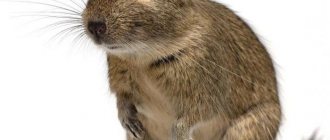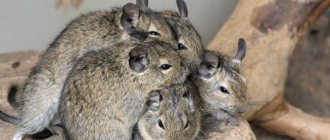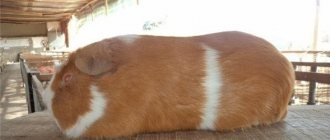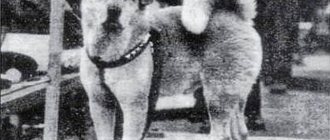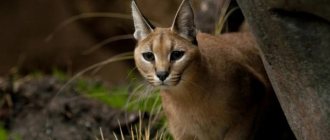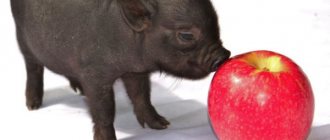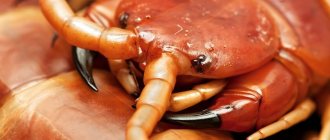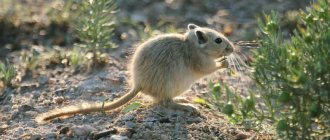Far across the ocean, in hot Venezuela, lives an amazing animal. It swims like an anaconda, has teeth like an alligator and crocodile, and has shiny fur like an otter. Who can guess what kind of animal this is? The correct answer is capybara
, but in Russia, Ukraine and Belarus, probably, few have heard of such an exotic creature.
The capybara is also called the capybara, and what’s most interesting is that many people keep this rodent in their homes. This is such an unusual alternative to praying mantises, hamsters, newts, rats and guinea pigs. True, keeping such an animal in an apartment will be very problematic, because the capybara weighs about 65 kg
, and the height is like that of an adult sheep. She simply loves water, and her entire body is covered with special water-repellent fur. Here are a couple more features of the capybara: long front teeth, similar to those of a rabbit, and the ability to bark like a dog.
Scientists consider the capybara to be the largest of rodents. Her whole life is closely connected with various bodies of water. The banks of rivers, swamps, and lakes are its usual habitat. These animals are amazingly dexterous swimmers and love to spend a huge amount of time in the water. Despite the rather large size of the capybara for a pet (body length 1.5 m) and considerable weight, many lovers of unusual animals still risked keeping this rodent. Many people find in him a resemblance to a guinea pig thanks to his cute little face, small, neat ears and movable nose.
"Capybara" is a name coined by the Indians of South America. Translated from their language it means “master of the grass.” But scientists, when they came across this mammal, could not find a name for it, because they had never seen anything like it. As a result of much deliberation, the researchers named it capybara and classified it as a rodent.
What does a capybara look like?
Everyone who is closely acquainted with the capybara considers it a very pretty animal. Its main advantage is its small tail, because often it is this part of the body that kills all a person’s love for rodents, such as rats and mice. The pensive, benevolent face of the capybara also evokes sympathy. The body of the animal is dense, well-fed, the head is massive. The hind legs are slightly shorter than the front legs, and it seems as if the capybara is constantly doing squats. The capybara has four toes on its front paws, but only three on its hind paws. There are membranes between the toes, thanks to which the animal can swim, and it also has quite sharp claws, so climbing a tree is not a problem for the capybara. The real pride of the capybara is its thick, long brown coat.
The capybara's eyes, nose and ears are located high, and therefore, when it bathes in a pond, its senses are not submerged under water. This way the rodent can calmly wait out the heat in comfortable conditions.
Description and dimensions
The capybara has short limbs ending in partially webbed toes. The forelimbs are characterized by the presence of four fingers, while the hind limbs have three fingers. The fingers have short and powerful claws. Unlike some rodents, the capybara does not have a tail.
Capybara
The capybara has a broad head with short, rounded ears, a large snout, and small, widely spaced nostrils. This large rodent is covered with coarse hair, 30 to 120 mm long. The color of the animal ranges from dark brown to reddish and from light brown to light yellow. The hairs are covered by sweat glands that are unique to capybaras. These animals are the only rodents that have sweat glands in their hair.
Hydrochaeris hyrochaeris weighs on average between 35 and 65.5 kg and has a body length of up to 1.35 m. Males have sebaceous glands on the top of the snout, a feature that indicates their sexual maturity. There are six pairs of nipples on the female's belly. The genitals of both sexes are hidden, making it difficult to determine the sex of the animal. Males' incisors are usually larger and wider than those of females of the same age.
Capybara grazing
How and where does the capybara live in nature?
Capybara is a herd animal
. They form groups led by a male and some females. The remaining males and a huge number of cubs are “subordinates”. Capybaras are very peaceful animals, so there are practically no quarrels in their family. Rights and responsibilities are clearly distributed, so the situation is most often calm. The whole group of animals roam the banks of reservoirs, stopping from time to time to rest. Capybaras do not sleep in burrows, but in the open. During the day, they look for water or dense thickets to hide from the sun, but the evening and morning coolness returns energy and activity to the rodents.
Capybara - Exotic Pet.
The largest rodent in the world is the Capybara. This cute animal is the only representative of the capybaras. Due to its size, the Capybara holds the status of a record holder among existing rodents. This animal is distributed mainly along the shores of water bodies in Central and South America. Refers to semi-aquatic herbivorous mammals. The weight of this rodent reaches 67 kg, and the body length of an adult is up to 134 cm. As a rule, females are larger than males. Capybaras live from 5 to 8 years. In captivity they can live 12 years.
Recently, it has become fashionable to keep capybaras as a pet. They look like massive dogs. If you are a lover of exotic animals, then you will definitely like the capybara!
What conditions are necessary to keep this animal?! It is worth remembering that capybaras require special care requirements.
WATER
Capybaras love to swim. They love to do almost everything in the water - eat, give birth and even sleep! Provide your capybara with a pool or pond where the animal can play during the day.
TEETH
Like all rodents, capybaras have long, sharp teeth that constantly grow. Therefore, they can chew wires, furniture and household appliances. Therefore, it is very important to make sure that your pet always has something to chew on so that their incisors wear down. Give the capybara birch and willow branches so that the animal can wear down its teeth.
SPACE
Forget the cage! These giants will take over your entire home. A capybara can be trained to use the toilet in the house by using a container of water for this purpose. The capybara is a very clean animal.
FOOD
Capybaras are vegetarians. They eat all types of fruits, vegetables and herbs. Don't forget to give them vitamin C. Just like guinea pigs, capybaras cannot produce vitamin C. Under natural conditions, capybaras eat grass and leaves to get this vitamin. In captivity, capybaras must be given vitamin C, otherwise the animal will get sick. Also, at home, the capybara can be fed raw fish, dry and canned dog food, hay, grain and rodent pellets. It is very important that the capybara’s diet is varied and complete.
COMPANY
Capybara is a herd animal! It cannot live alone, so you must provide the capybara with friendly company. If you decide to get a capybara, consider getting two at a time so they have someone to socialize and play with. This is very important, because in the company they feel happy and healthy. Capybaras are very shy and at the same time very sociable animals.
In their natural habitat they live in groups of 20 individuals. Capybaras are active in the evening and morning, and during the day, during the heat, capybaras rest in shelter or water areas.
Capybaras communicate with each other using clicking sounds and the smell of the secretion of the olfactory gland. They can also bark when they are alarmed by something and purr, thereby showing their submission.
GROWING UP
At the age of 15-18 months, capybaras become sexually mature. Pregnancy lasts about 150 days. Mating occurs in water, in April - May. Capybaras give birth on the ground, in open areas. On average, 4 cubs are born. If you breed a male at home, it is better to castrate him when he reaches sexual maturity, as they may begin to perceive their owner as an object of courtship.
ADVIСE
— Make sure there is a veterinarian in your area who can treat exotic animals.
— Before getting such a pet, make sure that they are allowed in your area.
- Think twice before getting a capybara. The capybara is more of a wild animal than a domestic animal.
- If your family has the strength and time to care for such demanding animals, then you can safely get this cute rodent.
— Capybaras love care and affection, don’t forget to scratch their belly!
Share on social media networks
If you liked the article, share the link with your friends!
How the capybara was hunted and then tamed
For many years, the only enemies of capybaras were forest and aquatic predators. But with the beginning of the colonization of America, people appreciated the warm fur and tasty meat of animals, and started a real hunt for them. In addition, the capybara was even considered a fish for a long time, and the colonists destroyed the peace-loving animals with redoubled zeal. Fortunately, people came to their senses in time. It was decided to build special farms and domesticate capybaras.
The capybaras liked the conditions on the farms. Of course: there is plenty of food, spacious reservoirs in which you can swim and dive freely, and even the absence of the usual predators. Thanks to these factors, capybaras quickly multiplied, unaware of the sad fate awaiting them.
Reproduction and young
The peak mating season is April-May in Venezuela, and October-November in Brazil. During the period of estrus, the female's scent changes, and males nearby begin to pursue. In addition to the smell, the female notifies the males about estrus by emitting a slight whistle with her nose. The choice of mating partner remains with the female. Capybaras only mate in water, so if a female does not want to mate with a particular male, she will dive or leave the water altogether.
Dominant males protect females from their group, but cannot prevent them from mating with subordinate males lower in the group hierarchy. The larger the group, the less attention the dominant males can pay to each female. Dominant males have a higher chance of mating with a female, but subordinate males as a class have more matings than dominant males.
Pregnancy lasts 130-150 days. One to eight puppies are born in one litter, with an average of 4 cubs. Females give birth on land, and join the group with their newborns just hours after giving birth. Baby capybaras are born well prepared for an active life - with teeth, fur and open eyes. At birth, the cubs weigh about 1.5 kg.
After a week, the puppies are already eating grass, but continue to suckle up to 16 weeks. Adult capybaras care for all the young in the group, not just their own pups. Thus, the cubs receive breast milk not only from the mother, but also from other females of the group. Young capybaras reach sexual maturity at 15-18 months, with a live weight of about 30-40 kg. A female can give birth to 2-3 litters per year under favorable conditions, but more often females give birth only once a year.
Pets are capybaras. Rules of care
Many people, once they have seen a capybara, or even read about it on the Internet or in a magazine, dream of owning such an animal. And this is not a bad idea at all! Indeed, a capybara can bark like a dog
, but does not growl and will never bite your guests. She quickly gets used to it and becomes almost a member of the family. This animal shares its calm energy with all residents of the house; its behavior suppresses aggression, calms nervous nerves and puts you in a good mood. Capybaras can get along well even with dogs and cats.
It is strictly forbidden to put a capybara in a cage. These freedom-loving animals simply cannot survive in it. Yes, and rather large sizes require appropriate space. Capybaras also need a specific climate, because they are used to living in a warm place, so something like a greenhouse combined with an indoor pool will do.
Feeding a capybara is not difficult. Vegetables, fruits, fresh hay - this is their favorite diet. The capybara will not refuse canned dog food or rodent pellets. The animal will remember the place where the feeder is located very quickly.
Can you walk your capybara on a leash?
, like a dog, or you can let it run free. These animals are ideal swimming buddies and even teachers who will demonstrate by example the correct diving technique.
And finally, good news for apartment dwellers who want to have such an exotic pet: there are dwarf capybaras
. These animals are similar in size to rabbits (photo of rabbits), but they are much more active.
Features of character and lifestyle
They jealously guard the area where rodents live. Animals mark all the boundaries of their territory with a secretion produced by their scent glands. These glands are located on the head. Male capybaras often quarrel and fight.
Like any other group of animals, capybaras also have their own leader. And other males, claiming the place of the main one, can start a war with him. The leader, in turn, tries in every possible way to dominate and constantly show his status to others.
Weaker males have no choice but to submit to the authority of a stronger relative. Because they will not be able to survive outside the group.
Rodents have a phlegmatic temperament. They are a little apathetic and lazy. They are even lazy to create any housing for themselves, preferring to rest at night right on the ground. Sometimes they may dig a small hole to make it more comfortable to lie down.The animals begin to be active after dusk. During the daytime, they are almost constantly in the pond, this allows their body to cool down.
Each flock usually contains up to 20 individuals. But during periods of severe drought there are many more of them. When communicating with each other, the capybara (photo of the animal) makes a sound similar to whistling, clicking or barking. A rodent barks in a dangerous situation, warning its associates.
